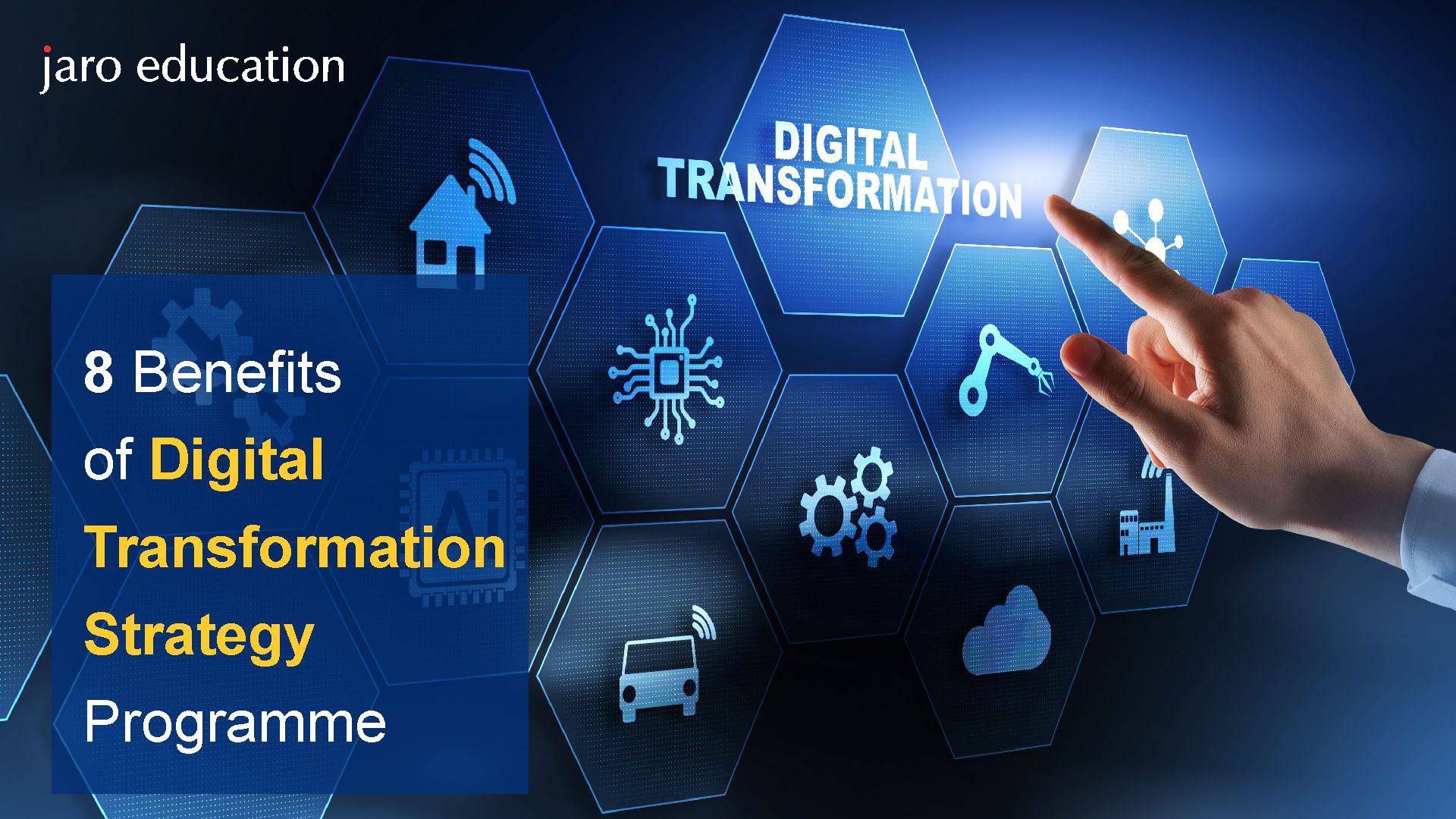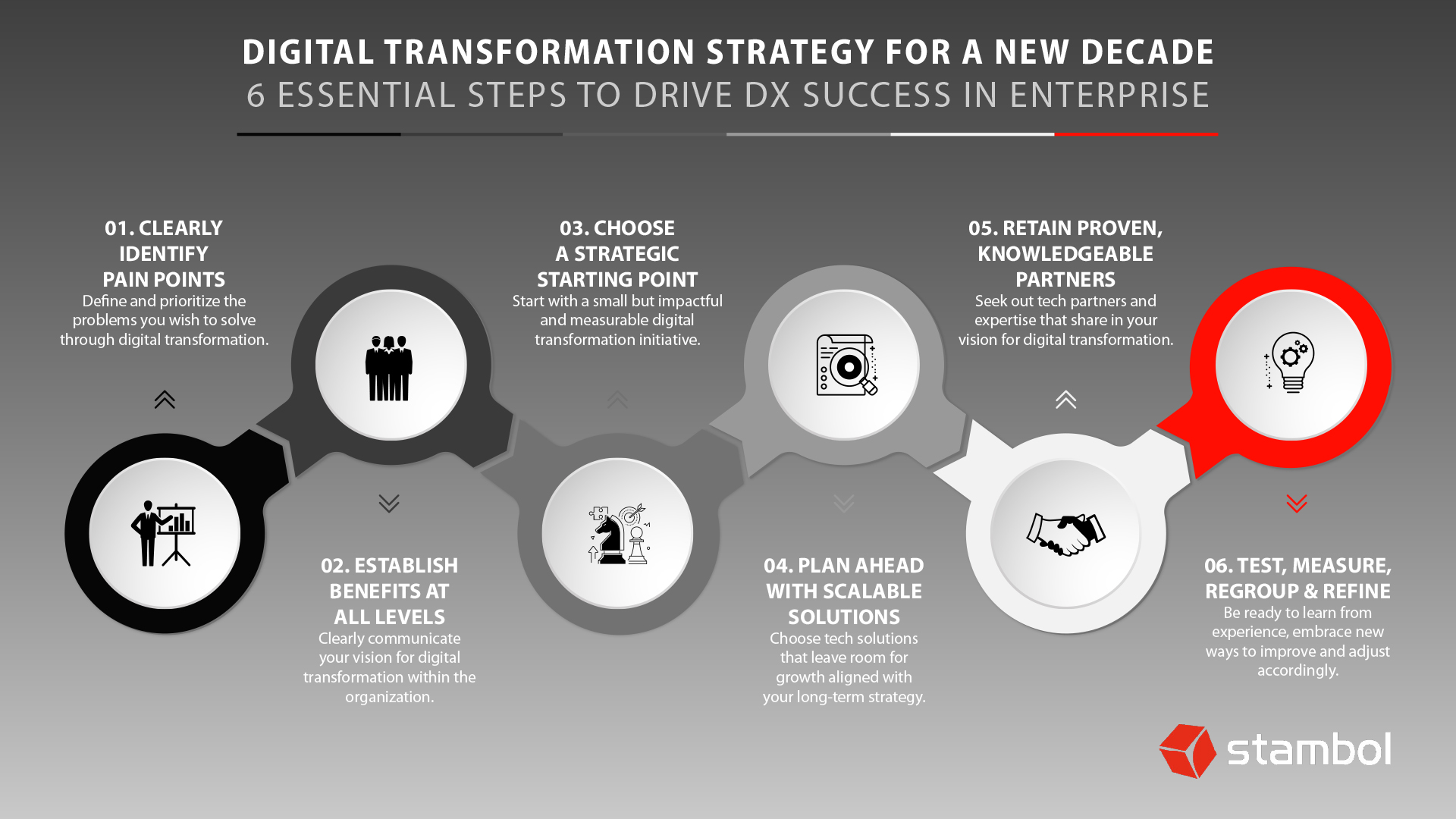In today's rapidly evolving business landscape, digital transformation strategies are no longer optional; they are essential for survival and growth. Organizations must embrace a comprehensive approach to integrate new technologies, reshape their operations, and enhance customer engagement. This article delves deep into the core aspects of these strategies, exploring how businesses can successfully navigate this digital revolution.
Understanding the Essence of Digital Transformation

Digital transformation is not just about adopting new technologies; it represents a holistic reimagining of how businesses operate, think, and interact in the digital age. The process involves redefining organizational culture, optimizing workflows, and enhancing customer experiences through innovative technological solutions.
The Importance of a Comprehensive Approach

A successful digital transformation strategy requires a well-thought-out plan that addresses various aspects of business operations. The focus should be on building an agile organization that can adapt quickly to changes in market dynamics, consumer behavior, and technological advancements.
Fostering a culture of innovation and openness is crucial during this transition. By encouraging employees to embrace new ideas and technologies, organizations can harness the collective intelligence within their workforce, enabling greater collaboration and creativity.
Integrating Smart Technologies
The integration of intelligent technologies such as artificial intelligence (AI), big data analytics, and automation plays a pivotal role in driving digital transformation. These tools empower businesses to analyze vast amounts of data, gaining insights that inform decision-making processes and streamline operations.
For instance, AI can predict consumer preferences and enhance personalization, leading to improved customer satisfaction and loyalty. Similarly, leveraging big data allows companies to identify trends and optimize marketing strategies, ensuring they remain competitive in a crowded marketplace.
Leadership's Role in Driving Change
Strong leadership is vital for navigating the complexities of digital transformation. Leaders must articulate a clear vision and create an environment that fosters collaboration and accountability. They need to champion change initiatives and inspire their teams to embrace new ways of working.
Moreover, leaders should prioritize training and development to equip employees with the skills necessary for success in a digital-first world. By investing in talent development, organizations can build a workforce that is not only adaptable but also capable of driving further innovation.
Key Elements of Successful Digital Transformation Strategies

To embark on a successful digital transformation journey, organizations must consider several critical elements. Each aspect contributes to creating a robust framework that supports ongoing transformation and growth.
Defining Clear Strategic Objectives
Establishing clear strategic objectives is essential for guiding digital transformation efforts. Organizations need to identify specific goals aligned with their overall business strategy, ensuring that each initiative contributes to achieving desired outcomes.
When setting objectives, it's important to consider customer needs and market conditions. By understanding what drives value for customers, organizations can tailor their transformation strategies to deliver meaningful results.
Conducting a Comprehensive SWOT Analysis
A thorough SWOT analysis serves as a foundation for identifying strengths, weaknesses, opportunities, and threats during the digital transformation process. This assessment provides valuable insights into the organization's current state and helps pinpoint areas for improvement.
By recognizing internal capabilities and external challenges, businesses can develop actionable strategies that leverage their strengths while addressing weaknesses. This proactive approach enables organizations to stay ahead of competitors and capitalize on emerging opportunities.
Embracing Agility and Flexibility
In a fast-paced digital environment, agility and flexibility are crucial for success. Organizations must cultivate a culture that embraces change, allowing them to quickly pivot and adapt to new market realities.
Implementing agile methodologies fosters collaboration and encourages iterative development, enabling teams to respond promptly to feedback and evolving requirements. This responsive mindset can significantly enhance an organization's ability to innovate and meet the demands of customers effectively.
Focusing on Customer-Centricity
Ultimately, successful digital transformation strategies hinge on understanding and meeting customer needs. Organizations should prioritize customer-centric approaches, leveraging technology to enhance interactions and create personalized experiences.
By utilizing data analytics to gain insights into customer behavior, businesses can tailor their offerings and communication strategies. This focus on customer experience not only improves satisfaction but also fosters long-term loyalty and advocacy.
Creating Value Through Technology Integration

Technology is a powerful enabler of value creation in the digital landscape. Organizations must thoughtfully explore how they can leverage technology to enhance their operations, products, and services.
Leveraging Data Analytics for Insights
Data analytics plays a critical role in extracting valuable insights from vast data sets. By analyzing customer behavior and preferences, organizations can make informed decisions that drive growth and improve product offerings.
For example, e-commerce platforms can utilize data analytics to track purchasing patterns, enabling them to recommend products tailored to individual customers. This level of personalization enhances the shopping experience and increases the likelihood of repeat purchases.
Personalization as a Key Differentiator
In an era where consumers expect personalized experiences, organizations must prioritize personalization in their digital transformation efforts. Tailoring content and offerings to individual preferences can significantly impact customer satisfaction and retention.
Companies like Netflix and Spotify have set industry standards by providing personalized recommendations based on user behavior and preferences. By implementing similar strategies, organizations can differentiate themselves and foster deeper connections with their customers.
Innovating Service Delivery Models
Embracing technology also opens new avenues for innovating service delivery models. For instance, businesses can explore subscription-based models, on-demand services, or virtual engagements to cater to changing consumer expectations.
By rethinking traditional service delivery methods, organizations can create unique value propositions that resonate with customers. This proactive approach positions businesses as industry leaders rather than followers.
The Synergy Between Technology and Creativity
While technology is vital for driving efficiency, it is equally important to nurture creativity within the organization. The intersection of technology and creativity leads to the development of innovative solutions that address complex customer challenges.
More detail : Artificial Intelligence: Building the Digital Future
Encouraging teams to collaborate and brainstorm ideas can result in fresh perspectives and novel approaches to problem-solving. By fostering a culture of innovation, organizations can consistently generate new ideas that keep them ahead of the competition.
Building a Culture of Innovation and Continuous Improvement

An effective digital transformation strategy cannot thrive without a strong culture of innovation. Organizations must create an environment where employees feel empowered to experiment, learn, and grow.
Digital transformation strategies : Encouraging Experimentation and Risk-Taking
A culture that embraces experimentation and risk-taking is essential for driving innovation. Organizations should encourage employees to propose new ideas and test them, even if failure is a possibility.
By framing failures as opportunities for learning, organizations can stimulate creativity and exploration. Employees who feel safe to take risks are more likely to contribute valuable insights that can lead to groundbreaking solutions.

Learning from Mistakes and Iterating
Continuous improvement is fundamental to successful digital transformation. Organizations should establish mechanisms for gathering feedback and iterating on processes and solutions.
By regularly assessing performance and learning from past experiences, businesses can refine their strategies and enhance their offerings. This commitment to learning enables organizations to stay agile and responsive to evolving market demands.
Empowering Employees as Change Agents
Empowering employees to become change agents is vital for fostering a culture of innovation. Organizations should provide training and resources that enable employees to contribute actively to transformation initiatives.
When employees see themselves as integral

contributors to the organization's success, they are more likely to engage fully in the transformation journey. This sense of ownership promotes a positive workplace culture that drives sustained innovation.
Celebrating Successes and Recognizing Contributions
Recognizing and celebrating successes, both big and small, fosters a positive culture that reinforces employee engagement. Acknowledging the contributions of individuals and teams creates a sense of belonging and motivates employees to continue pushing the boundaries of innovation.
Organizations should implement recognition programs that highlight achievements related to digital transformation initiatives. This practice not only boosts morale but also inspires other employees to strive for excellence.
Navigating Change Management in Digital Transformation

Implementing digital transformation initiatives is not just about technology; it’s also fundamentally about people. Transitioning to a more digital-oriented approach often comes with challenges, and effective change management strategies are crucial in facilitating this shift.
Gaining the support and buy-in from all levels of the organization ensures a smoother transition. Understanding how to manage change effectively allows organizations to mitigate resistance, cultivate adaptability, and ultimately ensure a successful digital transformation journey.
Digital transformation strategies : Engaging Stakeholders at All Levels
Engaging stakeholders throughout the digital transformation process is essential for ensuring that everyone feels included and valued. From senior leadership to front-line employees, fostering open communication lays the groundwork for a collaborative environment that's conducive to change.
When stakeholders understand how changes will impact their roles, they are more likely to embrace new processes and technologies. Regular updates, transparent discussions, and involving team members in decision-making processes can significantly increase engagement and support. This collaborative approach demystifies the change and builds confidence among employees regarding the goals of the transformation.
Providing clear channels for feedback and addressing concerns promptly helps create trust. Organizations that actively listen to their employees foster a sense of belonging and community, which reduces feelings of alienation during periods of uncertainty.
Training and Development Initiatives
Investing in training and development is a critical component when navigating organizational change. As technology evolves, employees need to enhance their skills to keep up with new tools, systems, and methodologies.
Tailoring training programs to address specific gaps ensures that employees feel prepared and capable in their roles as the organization transforms. Offering varied learning formats—such as online courses, workshops, and mentorship programs—caters to diverse learning preferences and promotes inclusion among team members.
Moreover, cultivating a continuous learning culture encourages employees to see change as an opportunity for professional growth rather than a threat. When individuals feel empowered to develop their skills, it enhances their agility in adapting to new processes, which is crucial during any digital transformation initiative.
Communicating Vision and Purpose
For any change initiative to succeed, there needs to be a compelling vision that galvanizes employees around a common purpose. Crafting and communicating the overarching objectives of digital transformation creates clarity and inspires action at all levels.
Success stories and case studies can help paint a vivid picture of what the transformation aims to achieve. By showcasing how similar organizations have benefited from embracing digital solutions, employees can envision the potential advantages for themselves and the company.
Frequent reminders of the why behind the transformation through various channels—team meetings, newsletters, or intranet pages—reinforce the message. An informed and aligned workforce is better equipped to tackle challenges, as they understand their role within the larger context of the organization's mission.
Addressing Resistance and Fostering Resilience
Resistance to change is natural, and organizations must recognize and address it thoughtfully. Identifying potential sources of resistance early allows leaders to implement preemptive measures to assist those struggling with the transition.
Creating safe spaces for dialogue where employees can voice their concerns and discuss feelings of apprehension can facilitate understanding. Listening to dissent and recognizing its validity demonstrates respect and empathy while allowing leaders to adjust strategies accordingly.
Fostering resilience is equally important. Organizations should encourage a mindset that views challenges as opportunities to innovate and adapt. Recognizing and rewarding resilience in the workplace instills positivity and motivates others to embrace change. Building resilience helps teams remain agile in the face of adversity, ensuring they remain focused on achieving long-term goals amidst short-term disruptions.
Harnessing Leadership in Digital Transformation
Leadership plays a pivotal role in shaping the trajectory of digital transformation initiatives. Strong visionary leaders empower teams, champion innovation, and demonstrate commitment to change. In a transformative climate, effective leadership characterized by adaptability, inclusivity, and purpose is paramount.
Setting a Clear Direction
Leaders must articulate a clear vision for digital transformation, setting tangible objectives that align with the organization's strategic goals. This clarity directs the efforts of all employees, providing them with a roadmap toward successful implementation.
By establishing a well-defined strategy, leaders eliminate ambiguity and inspire confidence in their teams. A clear direction helps embed accountability and aids in measuring success along the way. With the necessary framework in place, every team member can actively contribute to realizing the vision.
Championing a Unified Culture
Building a unified organizational culture is vital for driving digital transformation forward. Leaders set the tone by exemplifying values such as collaboration, innovation, and adaptability. These cultural principles become embedded in the organization's DNA and encourage employees to adopt a similar approach.
Encouraging cross-functional collaboration enables diverse perspectives to come together, enhancing creativity, problem-solving abilities, and overall innovation. As teams break down silos and work collaboratively toward shared objectives, they create a vibrant working environment that fosters greater engagement.
Additionally, leaders should promote inclusivity, ensuring that all voices are heard. A culture that values diverse input empowers individuals to share ideas freely, contributing to a richer and more comprehensive problem-solving process.
Leading By Example
Leadership by example is one of the most potent tools in the hands of influential leaders. When leaders enthusiastically embrace digital tools and practices themselves, they serve as powerful advocates for the change they are championing.
Demonstrating curiosity and eagerness to learn positions leaders as relatable figures who walk alongside their teams during the transformation. Employees are more likely to follow suit if they see their leaders grappling with new technologies, seeking feedback, and continuously evolving themselves.
Furthermore, recognizing and celebrating progress—inclusive of both small wins and major milestones—encourages ongoing commitment. Leaders should highlight and reward behaviors that align with the organization’s transformation goals to reinforce the desired changes in mindset and culture.
Supporting Continuous Improvement
Leaders must be receptive to feedback from their teams, nurturing a culture of continuous improvement. Encouraging regular assessments—including retrospectives, surveys, and performance reviews—allows organizations to make data-informed adjustments to their transformation strategies.
Staying attuned to industry trends, customer feedback, and employee sentiment creates a dynamic environment that supports required pivots. By embracing flexibility and transformation as part of daily operations, organizations remain resilient and sustainable in the ever-evolving business landscape.
Through strong leadership, companies can navigate the complexities of digital transformation more effectively while inspiring teams to excel and grow into a future marked by opportunity rather than fear of change.
Video
Conclusion

Digital transformation represents an essential evolution for organizations committed to sustaining growth and relevance in today's fast-paced world. While the intricacies of managing change, fostering innovation, and building meaningful customer relationships may present challenges, the opportunity to thrive amid disruption far outweighs these hurdles. Embracing agility, technology integration, and investiture in people are key factors in successfully harnessing the power of digital transformation. The future belongs to those organizations that prioritize purposeful change and remain steadfast in their pursuit of exceptional excellence across all areas of operation. As the digital landscape continues to evolve, proactive adaptation becomes synonymous with success, ensuring organizations emerge as frontrunners in their respective industries.














